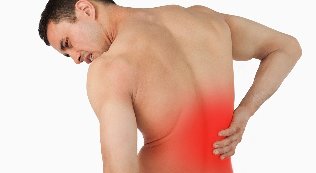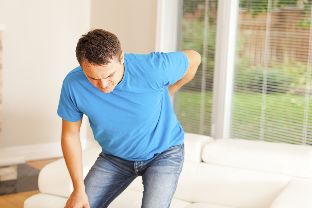Back pain - a frequent symptom of. Most people at least once in his life faced with him. This is one of the most common reasons for visits to the doctor and crossing work.

Keywords: back ache, back pain, spine
Back pain can occur at any age, but more often it occurs between 35 and 55 years. Pain in the back related to how to work our bones, muscles, intervertebral discs, ligaments, tendons and nerves.
Pain in the spine may be caused by problems with the vertebrae, discs between them, the ligaments around the spinal column and discs, spinal brain and nerves, muscles of the back, the internal organs in the abdominal and pelvic area. Also cause pain in the upper back can be diseases of the aorta, tumors in the chest and inflammation of the spine.
Risk factors
The presence of risk factors increases the likelihood of developing this or that condition. For example, obesity significantly increases the risk of developing diabetes of the second type.
These factors are associated with an increased risk of developing back pain:
- office work;
- work, conjugate to a constant stress;
- pregnancy - pregnant women often suffer from pain in the spine;
- a sedentary lifestyle;
- age;
- depression;
- obesity/overweight;
- smoking;
- difficult to exercise;
- heavy physical labor.

Signs and symptoms of pain in the back
Symptom - it is what the patient feels, then, as evidence can notice the doctor. For example, pain is a symptom, then there is a rash - a sign.
The main symptom of pain in the spine is pain in any part of the back. Sometimes the pain extends to the buttocks and legs, or on the shoulder and hands.
You should immediately contact a doctor if the pain in the spine accompanied by any of the following symptoms:
- weight loss;
- high temperature (fever);
- back pain is not easier after a rest;
- pain, gives step;
- the pain down below the knee;
- the presence of fresh injuries of the spine;
- incontinence of urine (even small portions);
- difficulty urinating - urine passes with difficulty;
- faecal incontinence - loss of control over the process of defecation;
- numbness in the genital area;
- numbness in the rectal area;
- numbness in the buttocks.
Ask for the advice of a specialist, if you belong to one of the following groups:
- people under the age of 22 or over 55 years;
- patients who received steroids for several months;
- patients with cancer;
- patients once cancer;
- patients with low immunity.
The causes of back pain
The human spine is a complex structure that consists of muscles, ligaments, tendons, disks and bones. The intervertebral discs are located between each pair of vertebrae and function as shock absorbers of the friction. Problems with any of these components can lead to pain in the spine. In some cases, are the causes of pain to install, you cannot.

Stretching
Among the most common causes of pain in the region of the spine are:
- pulled a muscle;
- stretched ligaments;
- lifting heavy object in an incorrect posture;
- lifting a too heavy object;
- the result is a sharp and awkward operation;
- spasm of the muscles.
Structural problems
These structural problems can lead to the emergence of pain in the spine:
- protrusion of the intervertebral disc. The difference of the outer shell of the disk leads to vbuhanie its internal contents to the outside. This can lead to interference of the nerve, and in consequence, there is pain;
- hernia of the intervertebral disc - a bulging of the inner content of the disc of large dimensions;
- sciatica - acute and shooting pain that radiates in the buttocks and the back area of the foot, caused by a protrusion or hernia of the intervertebral disc, compressing the nerve;
- arthritis - patients with osteoarthritis usually have problems with joints of the hip, lumbar spine, knees and hands. In some cases, it may rise to stenosis of the spinal canal, because the space around the spinal cord narrows;
- abnormal curvature of the spine - if the spine bends in an unusual way, the patient is more likely to be suffer from back pain. An example of the abnormal bending is due to scoliosis in which the spine bends to the side;
- osteoporosis - bones, including the vertebrae become brittle and porous, which leads to an increase in their fragility.
Listed below are some other causes of pain in the spine:
- syndrome cauda equina - horse's tail is a bundle of nerve roots that are branches of the spinal cord. People with this syndrome the cauda equina, who feel a dull pain in the lumbar spine and buttocks. It may also have a place, loss of sensation of the buttocks, genitals, hip. Sometimes people with this syndrome cauda equina syndrome suffer from incontinence of urine and/or stool;
- cancer of the spine - a tumor located in the spine, it can squeeze the nerve, causing pain;
- infection of the spine - if the patient observed high body temperature, and also painful, warm area on the back, then it could talk about the infection of the spine;
- other infection - inflammation of the pelvic organs in women, infection of the urinary bladder and kidneys, may also cause pain in the back;
- sleep disorders - people with sleep disorders often experiencing pain in the back in relation to the total population;
- tinea infection that can affect your nerves;
- bad mattress - if a mattress does not support specific parts of the body and provides the equal position of the back, there is a risk of developing pain in the spine.
Also cause pain in the spine can become certain movements or body position, as it is a longer drive, cough, etc.

What to do when back hurts
If you are experiencing pain in the spine in the course of a few days, then the following tips will help you reduce the pain and discomfort and speed up recovery:
- stay active as possible;
- according to the needs of the use of OTC painkillers;
- use hot and cold compresses. Will fit even a bottle of warm water, and a package of frozen vegetables.
Despite the fact that it's hard to stay optimistic when you're suffering from pain, try not to regret it. This will speed up the process of healing.
In the long-term pain in the spine, which takes place for six weeks, it is necessary to seek medical help. The doctor will medical history, performs a physical examination, and, if necessary, refers to other studies. The doctor may prescribe a chest x-rays in the case of a suspected problem with the skeletal system or osteoarthrosis, CT (ct) or MRI (magnetic-resonance imaging and ct) for suspected intervertebral hernia or other problems associated with soft tissues or nerves. In such a situation, MRI is the best choice. Also, the doctor may recommend to give up some laboratory tests or to measure the electrical activity of the nerves (EMG).
After diagnosis the doctor will prescribe treatment. For most cases it is enough a conservative treatment, which may include:
- special exercises;
- reflexology;
- traction of the spine;
- massage.
In serious cases can be raised the question about doing the surgery. Your doctor Will help you choose the appropriate method, and also advise on the possible complications. Through some time after the surgery is recommended completion of preventive medical treatment of the spine. Remember that surgery on the spine is dangerous enough, because the operating zone is located in close proximity to the nerves.





































